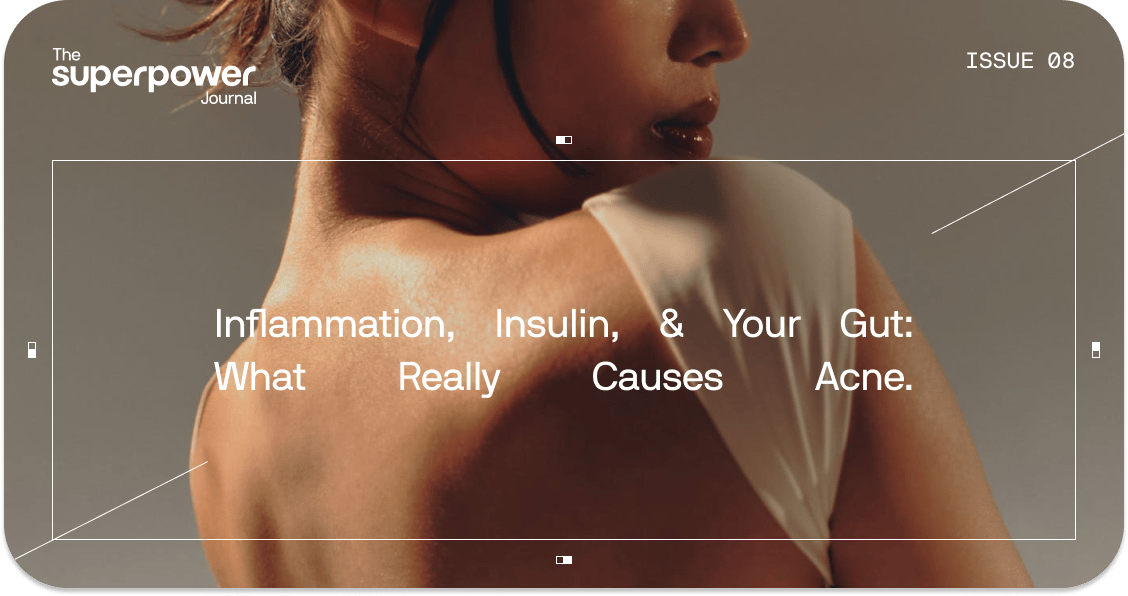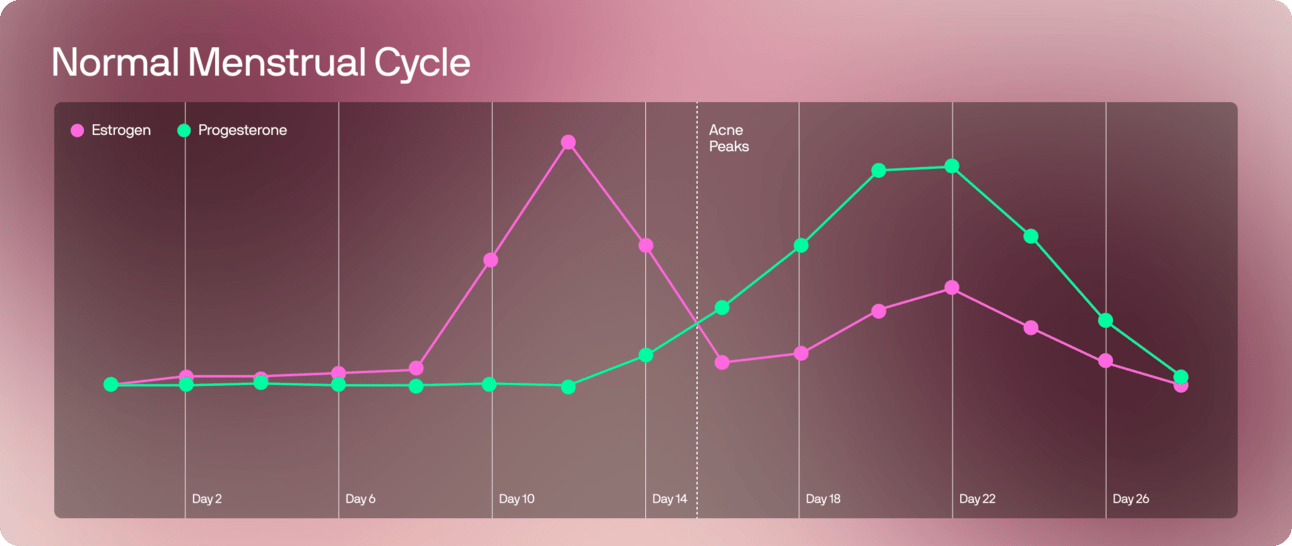- Superpower Journal
- Posts
- Inflammation, Insulin, & Your Gut: What Really Causes Acne Post
Inflammation, Insulin, & Your Gut: What Really Causes Acne Post

Read time: 4 mins
If you grew up in the ’90s or 2000s, you probably got your acne advice from cheesy skincare ads (scrub your pizza-face clean with magic soap, and suddenly you're prom royalty).
But those ads lied.
Acne isn't about dirty skin or your age. It's your body signaling deeper issues.
Here's what's really behind your adult acne and what to do about it.

Acne is more than skin deep. It’s your hormones, immune system, inflammation and gut all contributing to the issue.
What actually causes acne?
Acne happens when pores get clogged by excess oil (sebum), dead skin cells, and bacteria.
But the real issue starts deeper.
Acne isn’t just about bacteria. It's inflammation.
Studies show internal inflammation happens long before pimples appear1 .
People with acne often have high inflammation markers like C-reactive protein (CRP)2 (a sign your immune system is involved3 .
Gut microbiome and gut-skin axis.
Something else that causes inflammation? Dysbiosis.
When your gut bacteria gets out of balance (known as dysbiosis), it can rile up your immune system, fueling acne even more4 .
Insulin and sugar spikes.
Sugar-heavy diets spike insulin, activating pathways like mTORC15 , which increases oil production and skin cell growth, perfect conditions for acne6 .
Dairy, especially skim milk, can also trigger acne by raising IGF-1 (though your response depends partly on genetics7 .
Hormonal imbalances (women)
Adult female acne often ties back to androgens: higher "male" hormones like testosterone, or extra sensitivity to them.
These hormones supercharge your oil glands, flooding skin with sebum8 .
That's why hormonal shifts, like before your period, pregnancy, or perimenopause, can worsen acne.

As estrogen peaks mid-cycle, skin is clearer and calmer. Progesterone climbs and estrogen drops just before your period. This rapid hormonal shift can result in premenstrual acne breakouts, often along the chin, jawline, and lower face.
Hormonal imbalances (men)
Men naturally have high testosterone, which drives acne.
Those extra-sensitive or with very high levels have worse breakouts. Steroid users are nearly 4x more likely to develop severe acne needing medical help9 .
Stress and sleep:
Stress releases cortisol, increasing inflammation and oil production10. One study found students' acne worsened proportionally to their stress levels11.
Poor sleep also makes acne worse12, and brings on sleep-deprived sugar cravings that spike insulin13.
Genetics:
You're three times more likely to develop acne if it runs in your family14 .
Researchers have linked TNF and IL‑1 gene variants to inflammation and oil gland overactivity (genome-wide association studies)15 .
Environmental pollution:
Air pollution triggers oxidative stress, draining antioxidants and ramping up inflammation and skin cell growth.
One study found severe air pollution raised acne odds by over 8 times16 .
Hot, humid weather also fuels acne. Every 1°C rise in ambient temperature can boost skin oil production by about 10%17 .
What can you do about it?
🥗 Diet & gut health
Reduce sugar and white carbs (low-glycemic diet) to lower insulin spikes.
Test reducing dairy.
Eat more fiber and prebiotic foods for gut health.
Try probiotics (Lactobacillus, Bifidobacterium).
Filter your water, it’s filled with skin-irritating toxins18.
Consider a gut microbiome test.
😴 Sleep & stress
Aim for 7–9 hours of quality sleep.
High stress = high cortisol = more breakouts.
⚤ Hormone balancing
Consider natural hormone regulators like inositol.
Myo-inositol is best for insulin sensitivity, while D-chiro-inositol may support androgen regulation in women with PCOS19 .
Men: avoid anabolic steroids or hormone supplements.
If hormonal imbalance is suspected, get tested (like with Superpower20 ).
🧪 Evidence-backed supplements
Vitamin D (1000–2000 IU/day): low levels are common in acne sufferers21 .
Zinc (15–30mg/day): reduces inflammation effectively22 .
Omega-3 fatty acids (2–3g EPA/DHA daily): shown to have a 79% acne improvement in studies23 .
Vitamin A*: regulates skin turnover and reduces sebum24 . *Note: medical supervision needed at high dosages.
Evening primrose oil: helps balance hormones and strengthen skin.
Chromium/berberine (for PCOS sufferers): regulate insulin, reduce androgenic acne (promising but preliminary)25 .
✨ Dermatologist-approved procedures
Skincare routine for acne-prone skin
Acne-prone skin isn't dirty; it's inflamed. Your goal? Calm it down, not scrub it into submission.
Key rules:
Less is more: Gentle, consistent routines beat aggressive “acne-fighting” regimens.
Barrier over burn: Most acne-prone skin has a weakened barrier. Harsh products only worsen inflammation and delay healing.
Treatment + tolerance: Effective actives (like retinoids or Benzoyl Peroxide) must be paired with barrier-supporting moisturizers.
Step 1: Cleanse (1–2x/day)
Use a gentle, non-stripping cleanser (glycerin, ceramides, panthenol).
Skip foaming scrubs, SLS, brushes and anything labeled “deep cleansing.” This will avoid stripping the skin.
Step 2: Treat (apply targeted ingredients at night)
Start slow with just one or two targeted ingredients:
Retinoids: unclogs + calms
Benzoyl Peroxide: kills acne bacteria
Azelaic Acid: soothes redness
Niacinamide: balances oil + barrier
Salicylic Acid: de-gunks pores
Step 3: Moisturize (AM + PM)
Use pore-safe moisturizers with ceramides, niacinamide, or squalane. Even oily skin needs hydration.
Step 4: Sun protection (daily)
Sun exposure worsens acne scars, redness, and post-inflammatory hyperpigmentation.
Go for oil-free mineral sunscreens (zinc or titanium).
Acne add-ons?
Pimple patches might feel like little stickers teenagers slap on before TikToks, but the science is legit. They’re tiny wound covers stopping you from picking (be honest, you do it), letting your skin actually heal28 .
Some even have hydrocolloid, which pulls out the gunk overnight.
Masks? The old-school clay ones with bentonite and kaolin, still hold up. They mop up excess oil, reduce shine, and give your skin a fighting chance.
And gentle chemical exfoliants (salicylic or mandelic acid) keep pores clear, just go easy.

Somehow, teenage Tash and friends thought this was a good way to reduce acne back in the 2000’s. Maybe the masks are doing their job, but those cucumbers?? 🤷♀️
Forget quick fixes and miracle cleansers.
The real key to lasting clear skin? Combining proven treatments tailored just for you.

Enjoyed this email?
Forward it to a friend or colleague who might find it valuable. Or share the signup link so they can join us directly!
We’re all about getting better.
Got thoughts, feedback, or ideas? Hit reply and let us know – we’re listening!
DISCLAIMER: The information provided in this newsletter is for educational purposes only and is not a substitute for professional medical advice, diagnosis, or treatment. Always consult your healthcare provider before making any changes to your health or wellness routine.